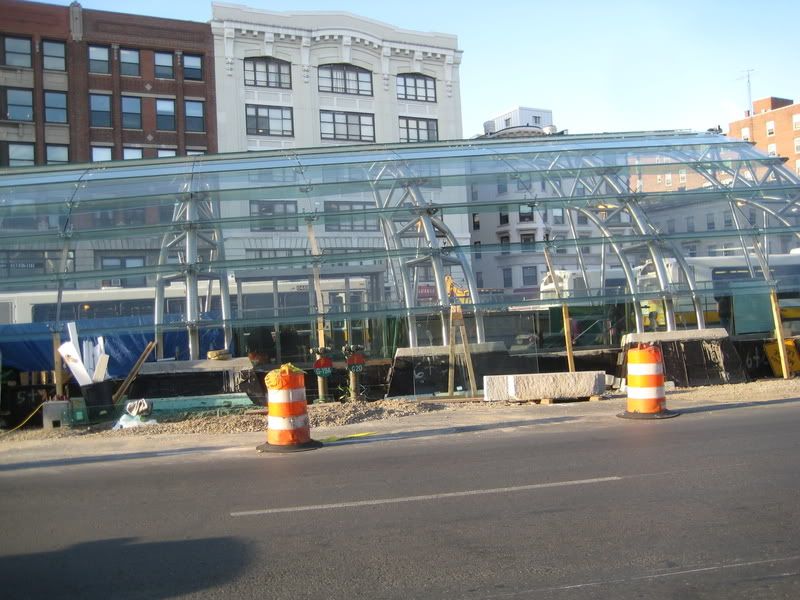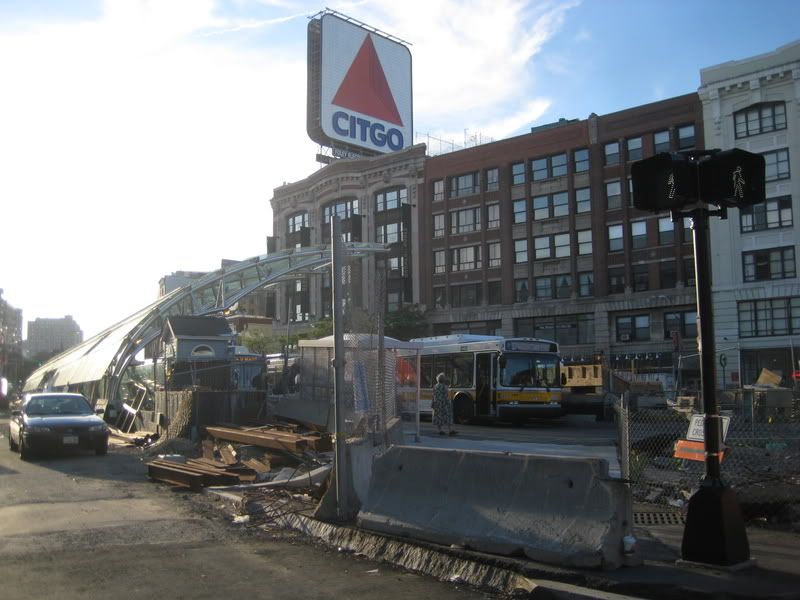Next stop: 21st century in Fields Corner
By Pete Stidman
News Editor
Great fanfare and a soon-to-be-cut bright red ribbon greeted commuters at the Fields Corner Red Line Station on Tuesday morning. Many of them sported confused looks as they mounted stairs to and from the station's new subway platforms - part of a $30 million station renovation - as they spied the governor, the mayor, MBTA general manager Daniel Grabauskas and every elected official in the neighborhood stepping up to a podium in the crosshairs of several TV cameras.
"I saw general manager Grabauskas and [state transportation secretary Bernard] Cohen get off the train this morning," state Sen. Jack Hart said to the crowd&emdash;praising Grabauskas' hands-on approach. "I thought it was a ceremonial first ride at first, I did. But it wasn't. They came here on the train from Beacon Hill."
Grabauskas himself thanked neighborhood activists for their influence in the new station's design, naming Tom Gannon, president of the Fields Corner Civic Association, Sandi Bagley, co-Chair of the Fields Corner Station' working committee and several others.
Gov. Deval Patrick plugged the new station's greater accessibility for people with disabilities, state Rep. Martin Walsh called Grabauskas a wonderful general manager "regardless of what you read in the newspaper," and Mayor Thomas Menino made a timely point, hailing Viet-AID's nearly completed project across the street from the station at 1460 Dorchester Ave.
"Transit-oriented development, it's good for our city, it's good for our environment," Menino said. "Let's continue to work together to make it happen."
The comment comes just a month after another Vietnamese-American Initiative for Development [Viet-AID] project - Bloomfield Gardens, on the opposite side of the station on Geneva Avenue - was delayed when several abutters argued against its proposed height and density at a Boston Redevelopment Authority meeting.
When Gannon took the microphone, he highlighted the vigilance needed by communities to push such projects along.
"In 1992, we started working on issues here. Now those issues are down to a minimum. We have been following this ball for 16 years," Gannon said, also touting the fact that the first Guinness beer was poured at the Blarney Stone bar in 1965 - a local claim to fame.
Rep. Walsh also sounded a historical note from the podium, recalling when members of Dorchester's former delegation in the State House, with names such as Thomas Finneran, Jim Brett, Paul White and William Bulger, first managed to get $67 million in the budget for the renovation of all four Dorchester stations back in 2000.
Rep. Marie St. Fleur added that a vote on the budget item - which slowly grew through multiple votes and MBTA appropriations to $100 million and made Ashmont Station's reconstruction a separate line item backed with a private developer's project (which became the Carruth Building) - was one of the first votes she took as a state lawmaker.
The Fields Corner renovation included a new station lobby, new platforms that accommodate six-car trains, new elevators and escalators, a new lobby and new bus ways, among other improvements.
With similar upgrades, Savin Hill station re-opened in 2005. A Shawmut Station rehab is largely complete, save the repair of some drainage problems at track level. And the T hopes to complete the Ashmont Station reconstruction next year.
Aside from maintenance concerns and a few details, many neighborhood leaders said they were happy with the project's results in Fields Corner.
"It's a world of difference from what it was years ago," said Lee Adelson, president of the Trinity Square Neighborhood Association, chair of the Fields Corner Main Street board, and also a member of the Fields Corner station's oversight committee. "We toured all the other stations and looked at what they had and what we didn't have. We didn't get everything we wanted. But we got just what we needed."
Although the working committee for the station rehabilitation has dissolved itself, Ed Crowley, a member of the Fields Corner Civic Association who also works days inspecting construction sites, said there is still reason to advocate a little before Barletta Construction and its sub-contractors leave the site entirely.
Asphalt in the station's new bus ways, installed by a sub-contractor, is buckling in several locations. The problem is likely due to an error in how the asphalt was bonded to the concrete underneath it, said Crowley.
In at least two spots viewed by the Reporter, heavy bus tires have re-molded the asphalt so much as to reveal the concrete underneath. That concrete underneath was apparently not scarified or torn up as city streets routinely are before they are repaved. In other locales on the bus way, the asphalt is being pushed up onto the sidewalk or into storm drains. The wavy road could provide a challenging job for snow plows this winter.
Crowley also looked to the bridge over the bus way, as well as the span across Dorchester Avenue, both of which fell outside of the project's purview. Both, with their crumbling concrete and rusty steel, provided a stark contrast to the brilliant shine of the new glass and metal station.
"That's a story for another day," he said.
LINK



